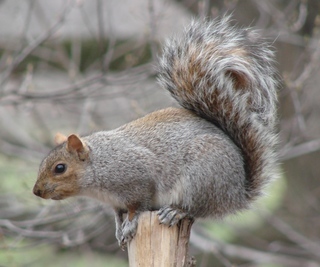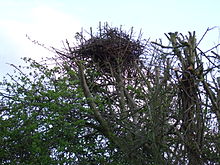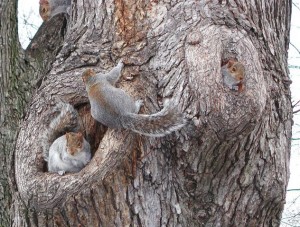Eastern Gray Squirrels are the predominant squirrels on UW campus. If you see a squirrel on campus, you can safely assume its an Eastern Gray. They are tree dwelling rodents of the family Sciurus. InWashington, they are an invasive species that were introduced in 1925. Some scientists believe that they may be the leading cause to the disappearance of our native Western Gray squirrels on the UW campus and in western Washington. They are an abundant, prolific, and adaptable species. Though they are native to the east coast and midwest, these squirrels do quite well on the west coast and have spread rapidly.

Source – discoverlife.org
Description
Like the name suggests, Eastern Grays are mostly gray in color, though they also have a mixture of reddish browns. They have white undersides and large, bushy tails. They can be from 23 to 30 centimeters in length and weigh from 400 to 600 grams. Generally, they are about the size of small cat or kitten. It is easy to tell them apart from their native Washington cousin, the Western Gray. Our native squirrels are solidly gray in color, lacking the reddish browns that Eastern Grays have. Also, when seen side by side, Western Grays are much larger and chunkier than their slender, smaller cousins.
How to Tell Them Apart
Gender - You can distinguish between males and females by their genitalia. From a distance, males and females may appear to be the same. However, during breeding season, when you see their undersides, you can tell them apart. If you can't see anything, the squirrel is most likely female. If you see testicles, it is a male.
+3a.jpg)
Above left: male during breeding season (http://angels-view.blogspot.com/2009/01/eastern-gray-squirrel-sciurus.html)
Above right: nursing female (http://www.flickr.com/photos/mansony/1347650595/)
Their gender is most obvious during breeding season, when you can see male squirrels' testicles and females have prominent nipples with which to feed their babies. During the breeding seasons, from December to January, and May to June, if you find a squirrel without testicles, it is definitely a female. During the non-breeding seasons, unless you are able to feel around, the gender could go either way. When it isn't breeding season, males carry their testicles inside their bodies. When it is breeding season, their testicles enlarge and become exposed.
Age - You can tell older squirrels from younger squirrels by their tails. Adolescent squirrels have furled tails until they are adults. Newborn squirrels are born pink with virtually no hair. They are helpless and can neither see nor hear. During the first 2 weeks of life, baby squirrels' ears begin to open and they start to turn grayish where fur starts to come in. A squirrel will begin to open his eyes and will be fully furred at 4 to 5 weeks old, at which point they no longer need supplemental heat. From weeks 6-9, the squirrel is still a baby needing help from the mother, but learning to socialize and play with litter mates while also being able to now eat solid food. From weeks 10-12, the young squirrel starts to look like a small adult (about 3/4 the size). After week 12, the squirrel looks much like an adult. After week 12, it is harder to tell how old the squirrel is until it is a senior, at which point the squirrel will start to get white fur around its eyes and nose, indicating old age. In the wild, most squirrels don't live past 1 year due to the harsh conditions, yet can live up to about 8 years. In captivity, squirrels can live from about 10 to even 20 years on average.
For in-depth information on a baby squirrels' adorable first weeks, click the following link!
http://squirrelrefuge.org/squirrel_refuge_web_site_005.htm
Habitat
Eastern Gray Squirrels build nests, called "dreys," in the forks or tops of trees. They construct these nests primarily from dry leaves and twigs. To the untrained eye, these dreys may look much like birds' nests.

Source- Palmiped on Wikipedia
Eastern Gray squirrels may also make dens from tree holes. They line these dens with mosses, grasses, and feathers to provide insulation and prevent heat loss.

Source - animaldiversity.ummz.umich.edu
Breeding
Breeding seasons for Eastern Grays is from December to
January and May to June. The first litter is born from February to March, and
the second from May to June. During breeding season, the males follow a female
around for days before she is even able to breed. The female emits a scent that
can attract males from over a kilometer away. There is only a brief approximate
8 hour period when a female squirrel is in estrus and is able to breed. When
the dominant male wins out over the less dominant males, the couple enter a
brief courtship before the female enters estrus and they mate. Males have no
role in the rearing process, it is the mother who takes care of the babies by
herself. The gestation period is about 44 days and the litter size is usually
2-6, though can be as high as 8. Young squirrels are weaned at 7 weeks old and
leave the nest at 10 weeks. Dominant young males leave the nest early to find
territory, and it is not unusual for young females to stay with their mothers
longer.

male squirrel chasing female - http://www.sciuridae.org/Sciurus%20carolinensis/reproduction%20-%20pursuit.html
baby squirrel - http://www.dominionpaper.ca/articles/3721
Diet
The Eastern Gray squirrel's diet consists of acorns,
berries, bird eggs, bulbs, buds, flowers, fruit, bark, insects, mushrooms,
fungi, nuts, pine seeds, roots, seeds, vegetables, and sometimes nestling
birds. Eastern grays are often seen in urban areas and love to steal food from
people's bird feeders. The average squirrel needs to eat about a pound of food
a week to maintain an active life.
Like all tree squirrels, Eastern Grays do not hibernate and
are active throughout the entire year. Usually, wild Eastern Gray squirrels are
wary and cautious of human presence, however, the squirrels of the UW are
visibly different. They are obviously much more accustomed to humans and are
known to even come up to people and take food from their hands. Squirrels
communicate with each other through a series of chirps. This added to tail
gestures form the basis for squirrel communication. When a squirrel senses
danger, its first instinct is to stand motionless. If it is able to, it will
climb up the nearest tree. If it is in a tree when sensing danger, the squirrel
will circle the tree and press its body close to the bark.
above image - http://blog.nwf.org/2012/04/what-a-squirrel-wants/
Written by Olisavia, final picture added by Tessa
above image - http://blog.nwf.org/2012/04/what-a-squirrel-wants/
 |
| Cat vs. Eastern Gray, courtesy of Josh Tewksbury |


At Blakes Wildlife Control, we have a team of experienced individuals. We specialize in Squirrel Removal Service since we have handled several projects. Working with us means you have experts on your side to help you resolve wildlife issues.
ReplyDeleteI truly like reading your post. Thank you so much for taking the time to share such nice information.
ReplyDeletehoneybees removal Atlanta